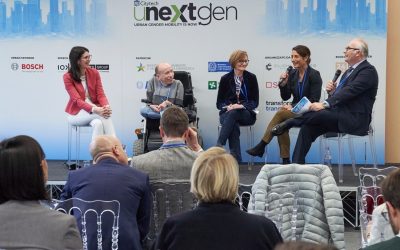Alina, data processing is becoming increasingly important in the field of transport planning. Our ioki product “Mobility Analytics” also works with data processing tools. Through the analysis region-specific mobility needs can be revealed. How does this work exactly?
When it comes to data-based transport planning to establish new on-demand solutions, we always take five steps into account during the analysis.
Step one consists of developing a detailed understanding of the planning area’s structure as well as of the transport situation on site. Different data sets are used to generate statistics-based theoretical users (agents) with specific mobility habits and individual routes. The result is a highly detailed, data-driven model that incorporates every aspect of demand for mobility. Next, we model journey times and the overall appeal of public transport travel and other means of transport for each individual agent. The result includes a map of areas where reaching public transport is difficult and where a demand-responsive transport system gives users better access to public transport. Once a potential operating area has been identified, an operational simulation for different scenarios takes place. The result is a detailed, tailor-made operations design for the whole region including fleet sizes, operating hours, the optimum service level and a lot of other service characteristics. However, this theoretical optimum says nothing about the economic viability of a demand-responsive transport offering. Another step is needed – a sensitivity analysis calculates and assesses the cost-to-revenue situation for all possible operating parameter combinations.
Based on mobility analytics an on-demand service can be implemented. What is the benefit of such a new, digital service?
In towns and cities, our partners can reduce the journey time of their passengers and further increase cost efficiency and the utilization level of their vehicles through intelligently pooled rides. On-demand services can be used as public transport feeders for a better connection to the city. The key success factor in these areas is the integration into the existing public transport environment to prevent parallel offers and even more cars that congest the roads.
In the countryside, our partners can reduce cost-intensive empty runs and gaps in their operating hours through the digitization of their services. Where economic viable, on-demand can be a bus substitution. With modern order functions such as a reliable pre-booking or an arrival-based booking function and pooling, they are also able to increase the number of potential users for their on-demand lines and shared taxis.
These new software solutions can thus strengthen the existing public transport structures. What exactly would this look like in the UK and how would users benefit in the end?
It is important to close the first and last mile gap in a specific area and improve connectivity especially to areas that are poorly connected to public transport.
On-demand services, which are deeply integrated into the existing public transport system and function as public transport feeders can link places more strongly together, connect specific places more closely to a metropolitan region and increase usage and adaptation. Using real-time data, mobility needs can be adapted to the demand of the user. No cannibalization of public transport should take place. The goal is to give people access to public transport and thus to increase their quality of life.
Let’s have a look into the future: How do you think the public transport market will develop and what role will the combination of autonomous driving and on-demand services play?
In the mobility of tomorrow, public transport, bicycles, and various forms of micro mobility offers are becoming increasingly popular, but the car will also continue to find its place. There will be many more electric vehicles powered by renewable electricity or hydrogen-powered vehicles; these will be shared by people through sharing concepts such as on-demand services. Hence, cars are not banished from the ideal vision of the future, but they will be used in such a way that there are fewer of them and that they will be shared. Today’s existing services will be digitized and a full integration of on-demand services in the existing public transport system (e.g. as feeders) will be standard. In addition to this, a smart combination and connection of different modes of transport will be common. If we add the factor “autonomous” to all this, we arrive at what is presumably the ideal picture of tomorrow’s mobility: electric cars that drive independently keeping traffic flowing smoothly and are networked with everything necessary and possible that their environment has to offer. In five years, there will be autonomous on-demand shuttles on the streets as part of a local public transport system. With “EVA-Shuttle”, ioki already launched an app-bookable, autonomous DRT service in the city of Karlsruhe.
Last but not least, there are many fascinating aspects to the subject of mobility. But what fascinates you personally about driving the mobility turnaround?
When I was a teenager, I lived in a small village in the north of Germany. The village was poorly connected to public transport. There was one train, which would take the inhabitants quite unfrequently to the next bigger city, but the inter-village network was very limited and visiting my friends in one of the neighboring villages took me either 1,5 hours by train or 45 minutes by bicycle. Travelling around was a big challenge and an on-demand shuttle service would have made my life so much easier. Well, today I can help cities and councils to reshape their ineffective public transport, push sustainable and innovative mobility solutions forward and thus increase the quality of life of the people on site.



